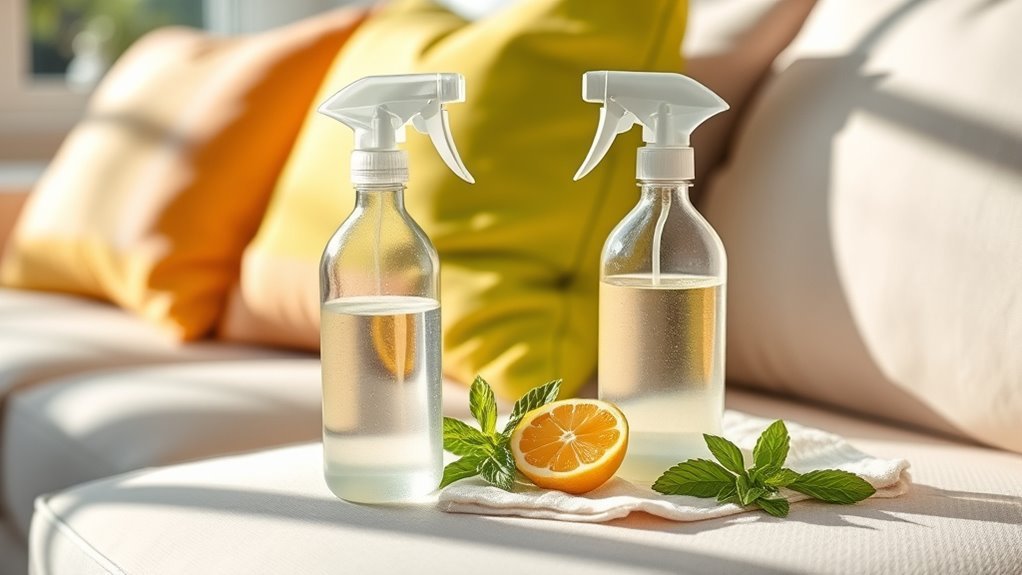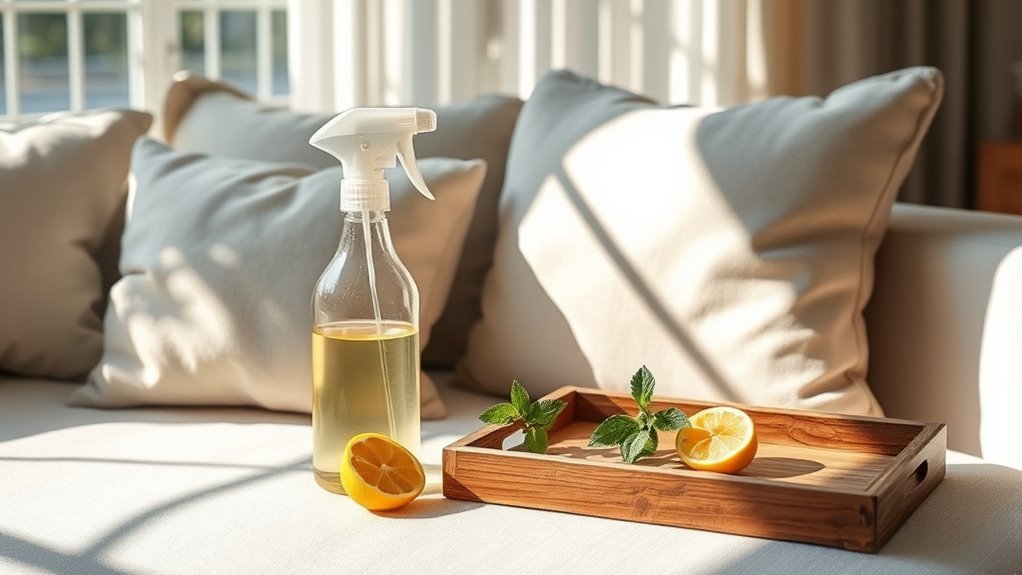DIY Cleaner for Sofa
You can easily make a safe, effective DIY cleaner for your sofa using simple ingredients like white vinegar, baking soda, and castile soap. These natural components help remove stains, odors, and grime without harsh chemicals, keeping your fabric fresh and protected. Always test your cleaner on a hidden spot first to avoid damage. Preparing your sofa properly guarantees the best results. Keep going to discover tailored recipes and tips for maintaining your sofa’s cleanliness and comfort.
Benefits of Using DIY Sofa Cleaners

Although professional cleaners can be effective, using DIY sofa cleaners gives you more control over the ingredients and process, ensuring your sofa stays fresh without harsh chemicals. When you make your own cleaner, you can choose eco friendly options that protect both your home and the planet. This freedom means no worries about synthetic additives or allergens. Plus, DIY solutions are often more cost effective than hiring pros or buying commercial products, saving you money while promoting sustainability. You get to decide exactly what goes into your cleaner, tailoring it to your needs and preferences. Embracing homemade sofa cleaners empowers you to maintain a healthier living space with minimal environmental impact, all while enjoying the satisfaction of handling the process yourself.
Essential Ingredients for Homemade Sofa Cleaners
When making your own sofa cleaner, you’ll want to focus on natural ingredients that won’t harm your fabric. Choosing stain-fighting components is key to tackling those tough spots effectively. Plus, it’s important to use solutions that are safe for your sofa’s material to keep it looking fresh and intact.
Natural Cleaning Ingredients
Choosing the right natural cleaning ingredients is key to making an effective homemade sofa cleaner. You want eco friendly alternatives that won’t harm your home or the planet. Ingredients like white vinegar, baking soda, and castile soap are popular in homemade recipes because they’re safe, affordable, and powerful. Vinegar cuts through grime, baking soda deodorizes, and castile soap gently lifts dirt without harsh chemicals. Adding a few drops of essential oils not only freshens your sofa but also keeps your cleaner naturally fragrant. These simple, natural components give you freedom to clean confidently, knowing you’re avoiding toxins while keeping your sofa spotless. Using these ingredients, you can create a versatile cleaner that’s easy on the environment and your family.
Stain Removal Components
To tackle stubborn stains on your sofa effectively, you’ll need specific stain removal components that work well with natural cleaners. Different stain types—like grease, ink, or wine—call for targeted ingredients such as baking soda, white vinegar, or hydrogen peroxide. These components break down stains without harsh chemicals, giving you freedom from toxic products. For example, baking soda absorbs oils, while vinegar cuts through acidic stains. Combining these with your preferred cleaning methods, like gentle scrubbing or blotting, guarantees you remove stains without damaging fabric. Knowing which components suit each stain type empowers you to customize your DIY cleaner precisely. This way, you stay in control, using safe, effective ingredients that align with your desire for a clean, fresh sofa and a toxin-free home.
Fabric-Safe Solutions
Although some cleaners can be harsh on delicate fabrics, you can create effective homemade solutions that protect your sofa’s material. Start by identifying your sofa’s fabric type—whether it’s cotton, linen, velvet, or microfiber—as this guides the ingredients you’ll use. For most fabric types, a gentle mix of water, mild dish soap, and white vinegar works wonders without causing damage. Avoid harsh chemicals, especially on sensitive materials like silk or suede. Adjust your cleaning frequency based on use; high-traffic sofas may need weekly touch-ups, while less-used pieces can tolerate monthly care. By tailoring your DIY cleaner to your fabric type and cleaning frequency, you maintain your sofa’s appearance and extend its life, all while enjoying the freedom of safe, homemade care.
Preparing Your Sofa for Cleaning
Before you start cleaning your sofa, you’ll want to remove any cushions, throws, or loose debris to get a clear surface. This sofa preparation step guarantees you can reach every spot without obstacles. Grab your essential cleaning tools—like a vacuum with an upholstery attachment, soft brushes, and microfiber cloths—so everything’s ready and within reach. Vacuum all crevices and seams thoroughly to lift dust and dirt, giving your sofa a fresh start. If your sofa has removable covers, take them off and check care labels for specific instructions. By preparing your sofa properly, you set yourself up for effective cleaning, making the process smoother and more satisfying. With the right prep, you’re free to tackle stains confidently and restore your sofa’s comfort and charm.
Simple DIY Cleaner Recipes for Different Fabrics

You’ll want to tailor your cleaner to the type of fabric on your sofa to avoid damage. Using natural ingredients like vinegar, baking soda, and essential oils can be both safe and effective. Let’s explore simple recipes that work best for different materials.
Fabric-Specific Cleaning Tips
Because every fabric reacts differently to cleaning solutions, it’s important to tailor your DIY cleaner to the material of your sofa. For delicate fabrics like silk or velvet, use a gentle mix of water and mild soap, testing a small area first to verify no damage. Cotton and linen can handle a bit more elbow grease with vinegar and water solutions. When it comes to fabric care, always check the manufacturer’s label for specific instructions and adjust your cleaning frequency accordingly—high-traffic sofas may need weekly attention, while less-used ones can be cleaned monthly. By respecting your sofa’s fabric type and cleaning frequency, you free yourself from worry and keep your space fresh without harsh chemicals or guesswork.
Natural Ingredient Combinations
When tackling sofa stains, combining natural ingredients can create effective cleaners tailored to your fabric’s needs. For delicate fabrics like silk or velvet, mix equal parts water and white vinegar with a teaspoon of gentle liquid soap—this natural combination lifts dirt without harsh chemicals. For sturdier fabrics like cotton or polyester, blend baking soda and water into a paste to tackle tough stains while deodorizing. These eco friendly alternatives not only protect your sofa but also reduce your environmental footprint. If you want to freshen up your couch, a spray made from water, lemon juice, and a few drops of essential oil works wonders. Embracing these natural combinations lets you keep your sofa clean with freedom, avoiding synthetic cleaners that can harm both fabric and planet.
Step-by-Step Guide to Removing Common Sofa Stains
Although tackling sofa stains can feel intimidating, having a clear plan makes the process much easier. First, identify the stain types—whether it’s coffee, pet accidents, or grease. Knowing this helps you choose the right natural cleaner. Next, blot the stain gently with a clean cloth to avoid spreading it. Apply your DIY solution according to the stain’s nature—vinegar and baking soda work well for many. Let it sit briefly, then blot again to lift the stain. Remember, regular cleaning frequency prevents stains from setting, making removal simpler. By staying consistent and addressing stains promptly, you maintain your sofa’s look and freedom from tough chemicals. This straightforward routine gives you control over your space and its cleanliness.
Techniques for Eliminating Sofa Odors Naturally

How do you banish stubborn odors from your sofa without harsh chemicals? You can embrace natural techniques that focus on odor absorption and invigorating sofa scents. Baking soda, for example, neutralizes smells effectively. Essential oils add a pleasant aroma while keeping things chemical-free. Here’s a quick guide:
| Technique | Benefit |
|---|---|
| Baking soda | Absorbs odors naturally |
| White vinegar spray | Neutralizes smells |
| Activated charcoal | Long-lasting absorption |
| Essential oil drops | Infuses fresh sofa scents |
Simply sprinkle baking soda, let it sit, then vacuum. Use a vinegar spray lightly and air dry. Activated charcoal bags work well tucked under cushions. Add a few drops of your favorite essential oil to keep freedom in your living space, free from synthetic chemicals.
Tips for Maintaining a Clean and Fresh Sofa
Keeping your sofa smelling fresh is a great start, but maintaining its overall cleanliness guarantees it looks inviting and lasts longer. For effective sofa maintenance, follow these simple tips:
- Regular Vacuuming: Remove dust, crumbs, and pet hair frequently to prevent buildup and keep your fresh upholstery vibrant.
- Spot Cleaning: Address spills immediately using a mild DIY cleaner to avoid stains setting in and damaging the fabric.
- Rotate Cushions: Flip and rotate cushions weekly to distribute wear evenly, preserving shape and comfort.
Precautions and Testing Before Applying DIY Cleaners
Before applying any DIY cleaner to your sofa, you should always test it on a small, hidden area first to confirm it won’t damage or discolor the fabric. This cleaning test helps you gauge your sofa’s fabric sensitivity and avoid costly mistakes. Different fabrics react uniquely, so take this simple step to protect your freedom to refresh your space without worry.
| Step | What to Do |
|---|---|
| Choose a hidden spot | Under cushions or sofa back |
| Apply cleaner | Dab a small amount, don’t soak |
| Wait and observe | Let it dry, check for color change |
| Assess results | If no damage, proceed with cleaning |
This approach guarantees your DIY cleaning is effective and safe, keeping your sofa vibrant and your home carefree.
Frequently Asked Questions
Can DIY Sofa Cleaners Damage Upholstery Warranty?
Did you know that 65% of upholstery warranties get voided due to improper cleaning? When you use DIY cleaners, you risk warranty implications because many manufacturers require specific upholstery care methods. While you want the freedom to clean your sofa your way, it’s essential to check your warranty terms first. Otherwise, your creative cleaning could end up costing you a new sofa or expensive repairs down the line.
How Often Should I Deep Clean My Sofa?
You should aim for a deep cleaning frequency of every 6 to 12 months to keep your sofa looking fresh and extending its life. Regular upholstery maintenance tips, like vacuuming weekly and tackling spills immediately, help reduce the need for intense cleanings. This routine gives you the freedom to enjoy your furniture without worry, keeping your space inviting and your sofa in great shape for years to come.
Are DIY Cleaners Safe for Pets and Children?
You’re right to wonder if DIY cleaners are safe for your pets and kids. When you use pet safe ingredients like vinegar, baking soda, and gentle essential oils, you’re choosing child friendly solutions that keep your home free from harsh chemicals. This way, you get the freedom to clean confidently, knowing your loved ones aren’t exposed to toxins. Just always test a small spot first and keep your little adventurers away during cleaning.
Can I Use DIY Cleaners on Leather Sofas?
You can use DIY cleaners on leather sofas, but you’ve gotta be careful with leather maintenance. Leather is delicate, so stick to gentle cleaning techniques like using a mix of water and mild soap or a bit of vinegar diluted in water. Always test any cleaner on a hidden spot first to avoid damage. With the right care, you’ll keep your sofa looking great while enjoying the freedom to customize your cleaning routine.
What Tools Do I Need for DIY Sofa Cleaning?
Think of yourself as a modern-day alchemist, turning everyday items into cleaning gold. To tackle your sofa, you’ll need suitable materials like soft brushes, microfiber cloths, a spray bottle, and gentle detergents. Mastering cleaning techniques such as spot testing and gentle blotting will set you free from harsh chemicals. With these tools and methods, you can refresh your sofa’s look while keeping its fabric safe and your space feeling liberated.






